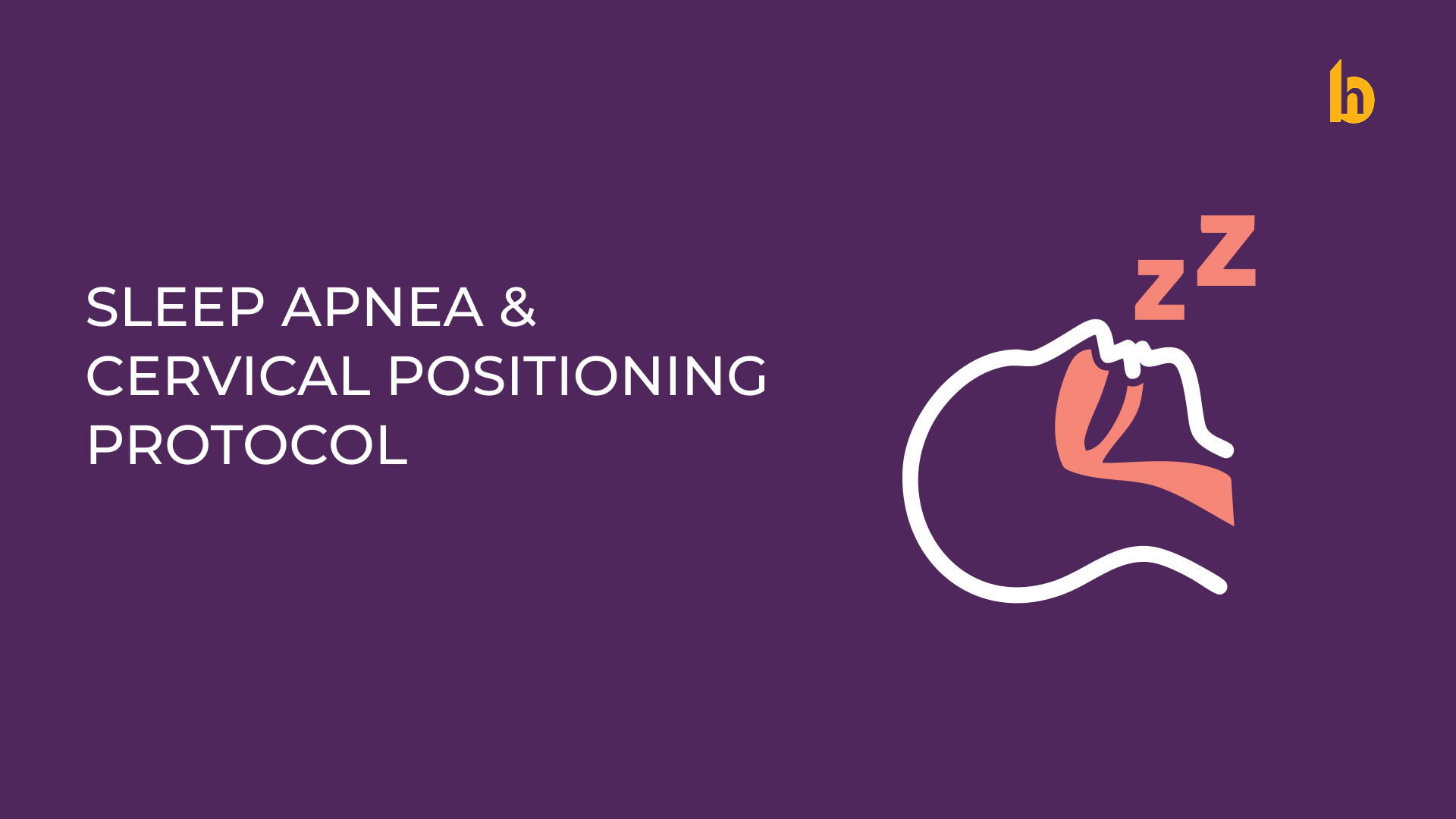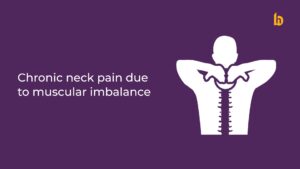If you woke up suddenly gasping for air, snored so loudly it woke others up, or felt exhausted after sleeping, even though you slept enough time, you may have obstructive sleep apnea (OSA). Most people know about CPAP machines which are a common treatment for OSA, but another factor people often do not consider is how you position your neck and spine as you sleep.
The position of your head, neck angle and spine will determine the alignment of your spine, and whether your airway is open, during sleep. It is possible that your sleeping position is either worsening or improving your symptoms, so knowing how you sleep may be a simple way for you to improve your sleeping and sleep breathing.
In this article, we’ll explore:
- What sleep apnea is
- How cervical positioning affects your breathing
- And evidence-based techniques that can help you sleep better and breathe more freely
Simple changes in how you sleep can lead to noticeable improvements in your health. Let’s start with the basics.
What is Sleep Apnea and Why Should You Care?
Sleep apnea is more than just snoring or waking up feeling tired. Sleep apnea is a chronic sleep disorder characterized by repeated stops and starts in breathing while you sleep. The most common type is called obstructive sleep apnea (OSA) when the soft tissue in the back of your throat relaxes too much, narrowing or blocking the airway and stopping airflow for several seconds. Each time you pause breathing, you will wake up, however briefly, to reopen your airway. You could be having dozens, if not hundreds of very short awakenings while you sleep, and although you won’t remember them, they can be sufficient to disturb your usual pattern of sleeping, leaving you feeling unrested and fatigued.
What Are the Types of Sleep Apnea?
- Obstructive Sleep Apnea (OSA): Caused by physical blockage in the throat when muscles relax during sleep.
- Central Sleep Apnea (CSA): Happens when the brain fails to signal your breathing muscles properly. It is often linked to heart or neurological conditions.
- Complex Sleep Apnea Syndrome: A combination of OSA and CSA. This may appear when someone starts CPAP therapy and then develops central apnea symptoms.
What Are the Symptoms and Health Risks?
Common symptoms include loud snoring, daytime fatigue, morning headaches, dry mouth, and trouble focusing. Untreated sleep apnea increases the risk of heart disease, stroke, high blood pressure, type 2 diabetes, and depression[1].
How Does Cervical Positioning Affect Sleep Apnea?
The manner in which you sleep can greatly influence how open your airway can be. When you are not in a good cervical position; for example, if your head is pushed forward, or your neck is too far flexed back, or too far flexed forward, the airway can narrow meaning that you increase the risk of a partial or complete airway obstruction and can make sleep apnea symptoms worse[2].
Besides helping ensure that you have a neutral neck position, maintaining a neutral neck position helps to maintain the natural lordosis of the cervical spine. This can also benefit the airway by reducing the chance of soft tissue in your throat collapsing. When your neck is in alignment, the airway is more open which allows for more air to flow freely during sleep.
This is especially important for us during REM sleep. So after relaxation, like in REM, you are relaxed and your muscles will be more relaxed than normal, including the muscles that surround your airway. If you are out of position at the cervical spine, then the relaxed muscles surrounding your airway are likely going to collapse, blocking your airway. If you are in good position with your cervical spine, then the relaxed muscles around your airway are less likely to collapse, and you will be better able to breathe normally all night long.
Another quick point is how we position ourselves can also place stress on our cervical spine and surrounding muscles which can become uncomfortable, wake you up, and keep you from getting good quality sleep. So, proper neck position is not just about breathing; it also can equally help you have a better sleep experience.
What is the Cervical Positioning Protocol for Sleep Apnea?
Cervical positioning protocols are non-intrusive methods to help support sleep and stability in a neutral neck position. Cervical positioning protocols are used to help maintain a neutral cervical spine to keep the airway open and relieve obstructive sleep apnea. The primary cervical positioning include:
- Positional Therapy: This means training the body to have sleep positions that promote neck and spine alignment- such as sleeping on your side instead of your back. Side sleeping will help ensure the tongue and soft tissues do not fall back into the airway or make it obstructed.
- Ergonomic Pillows: Pillows with special shapes support the natural curvature of the cervical spine. They help guide neck alignment, providing adequate support for the neck and head when someone sleeps so they don’t bend or tilt the neck in a way they would not have bent or tilted it while awake.
- Postural Training: Being aware and working to correct your posture throughout the day is important for improved cervical alignment during sleep. By learning how to be in one of the most optimal postures, you can reduce the stress on your neck muscles and create a better sleeping spine position.
- Targeted Physical Therapy Exercises: Specific exercises work the neck and upper back, improve soft tissue flexibility, and improve muscle strength balance. These exercises can strengthen the long-term maintenance of proper cervical alignment which may improve severity of sleep apnea symptoms over time.
Together, these techniques form a comprehensive cervical positioning protocol that can enhance airway patency, improve sleep quality, and complement other sleep apnea treatments.
Importance of Neutral Spine Alignment
Maintaining a neutral spine position with your head, shoulders and pelvis all aligned keeps the airway open and limits the number of breaks in breathing while sleeping. Research has shown that even slight changes in cervical posture can have large effects on collapsing the pharyngeal airway and increasing the likelihood of obstruction while sleeping [3]. This alignment promotes good airflow any time your muscles are relaxed but particularly during REM sleep. For patients with sleep apnea, adopting a neutral neck alignment may be an easily available, effective means of enhancing quality of breathing while sleeping.
Positional Therapy Strategies
Positional therapy concentrates on assisting you to avoid the positions that can exacerbate sleep apnea, particularly back-sleeping in the supine position, as sleeping on your back allows gravity down, to collapse the tongue and soft tissues toward the airway increasing the level of obstruction. Common positional therapy techniques include:
- Take a tennis ball and sew it to the back of your pajama top to discourage you from rolling onto your back while sleeping. The discomfort of the tennis ball will remind you to stay on your side.
- Using body pillows or wedge pillows creates support and promotes side sleeping. Side sleeping reduces the likelihood of soft tissue collapsing which helps keep your airway more open.
- Elevate the head of your bed a couple of inches using blocks or an adjustable bed frame. A slight incline utilizes gravity to minimize airway obstruction and keeps the airway more open.
These strategies can be easy yet effective ways to enhance breathing during sleep that do not require complex devices. When you combine positional therapy with other cervical positioning options, both the sleep apnea and daytime alertness will be improved.
Use of Cervical Pillows and Supports
Cervical pillows are designed to help position the neck in its natural cervical curve while sleeping. Cervical pillows hold the spine in better alignment, keeping the airways open while provide less soft tissue collapse that contribute to sleep apnea. One study found that custom cervical pillows significantly reduced apnea-hypopnea index (AHI) scores among patients with mild and moderate obstructive sleep apnea, meaning less interrupted breathing during sleep [4]. Materials, such as memory foam, contours to the natural curvature of the neck, therefore allowing the cervical pillow to support the neck and provide stability consistently throughout the night. When properly-determined with consideration to your cervical condition, a cervical pillow can be a simple yet helpful component of sleep apnea self-management.
Physical Therapy and Postural Training
Specific physical therapy and postural training exercises can help strengthen the muscles that stabilize the neck and prescription cervical alignment. Head and neck mobility, reducing forward head posture, and strengthening our deep cervical flexors allow for better airway stability during sleep. If you’re fortunate to work with a physiotherapist that can lead you through precise and carefully monitored exercises, you may include:
- Chin tucks, which help realign the head over the shoulders and reduce strain on neck muscles.
- Neck isometric exercises, designed to strengthen the muscles that support the cervical spine without excessive movement.
- Shoulder blade squeezes, which improve upper back posture and counteract the tendency to slump forward.
Regularly performing these exercises can enhance your neck’s strength and flexibility, supporting better cervical positioning during sleep. This, in turn, may reduce the severity of sleep apnea symptoms and improve overall sleep quality.
What Does the Research Say About Cervical Positioning and Sleep Apnea?
Multiple clinical studies support the role of cervical alignment in improving OSA outcomes:
- A 2020 study published in the Journal of Clinical Sleep Medicine showed that head and neck elevation improved upper airway dimensions and reduced apneic events[5].
- Research in Respiratory Physiology & Neurobiology found that forward head posture was strongly associated with airway collapsibility during sleep[6].
How Can You Incorporate the Cervical Protocol into Your Sleep Routine?
1. Sleep Position Recommendations
Side sleeping, especially on the left side, can significantly reduce OSA severity. Avoid sleeping on your back unless your upper body is elevated.
2. Pre-Sleep Stretching and Exercises
Try incorporating a short routine before bed:
- Neck rolls and lateral stretches
- Cat-cow stretch for the spine
- Chin tuck holds against a wall
These exercises loosen tight muscles and support spinal alignment.
3. Long-Term Benefits and Follow-Up
Adhering to cervical positioning protocols can lead to:
- Better quality sleep
- Reduced AHI scores
- Decreased reliance on CPAP
- Improved energy and cognitive function
Keep track of changes and consult your healthcare provider regularly.
What Other Treatments Complement Cervical Protocols?
CPAP and How Positioning Can Help
CPAP (Continuous Positive Airway Pressure) remains the gold standard for moderate to severe OSA. However, correct neck alignment can reduce the required CPAP pressure, making therapy more comfortable[7].
Oral Appliances and Posture
Mandibular advancement devices (MADs) reposition the lower jaw to prevent airway collapse. Combining MADs with cervical support improves compliance and effectiveness[8].
Lifestyle Modifications
Simple changes can reinforce the benefits of cervical positioning:
- Weight loss
- Quitting smoking
- Avoiding alcohol and sedatives before bed
- Managing allergies and nasal congestion
When Should You Seek Medical Help?
Red Flags and Urgency
Contact a healthcare provider if you experience:
- Loud, persistent snoring
- Pauses in breathing during sleep
- Excessive daytime sleepiness
- Waking up gasping or choking
These symptoms require diagnosis and may indicate a need for sleep studies.
Specialists You Should Consult
- Sleep medicine physician
- ENT (ear, nose, throat) specialist
- Physiotherapist with experience in airway and posture
- Pulmonologist
Conclusion
Sleep apnea is not just an issue of snoring, but a condition that needs to be dealt with. Although CPAP and other medical devices may still be indicated, cervical positioning can be a useful adjunct to sleep apnea treatment. When you learn how your cervical spine positioning may be impacting your airway, you will find options to reposition your head and neck more effectively for better sleep and better health.
A change in cervical positioning is a simple and effective way of supporting airway openness to assist in reducing apnea episodes naturally. Along with other treatments and lifestyle changes, cervical positioning will be an easy to implement strategy that has the potential to positively impact your overall quality of life, and limit the health risks that untreated sleep apnea poses. By implementing a few simple strategies towards better neck care while you sleep, it is possible to improve your sleep and health significantly.
Frequently Asked Questions
1. How does neck position affect breathing during sleep?
Incorrect neck positioning can narrow the airway and increase the risk of obstruction, especially in those with OSA.
2. Are there specific pillows that help with cervical alignment?
Yes, cervical contour pillows or memory foam pillows designed to maintain the natural curve of the neck can help.
3. Can cervical spine exercises reduce sleep apnea?
Exercises that improve posture and neck alignment may alleviate mild to moderate OSA symptoms.
4. Is cervical alignment a substitute for CPAP therapy?
No. It’s a helpful adjunct but not a replacement for prescribed medical treatment.
5. Should I consult a physiotherapist for sleep apnea-related posture issues?
Yes, especially one trained in sleep-related musculoskeletal therapy.
References
- https://www.nhlbi.nih.gov/health/sleep-apnea
- https://pubmed.ncbi.nlm.nih.gov/30884377/
- https://pubmed.ncbi.nlm.nih.gov/15105590/
- https://pubmed.ncbi.nlm.nih.gov/23629580/
- https://jcsm.aasm.org/doi/10.5664/jcsm.8470
- https://pubmed.ncbi.nlm.nih.gov/29336842/
- https://pubmed.ncbi.nlm.nih.gov/12034043/
- https://www.sciencedirect.com/science/article/abs/pii/S138994571830134X
















